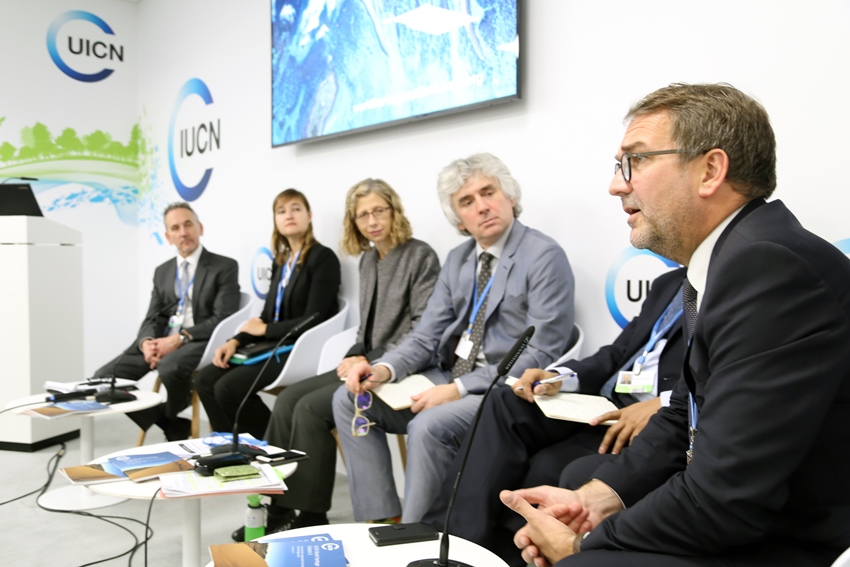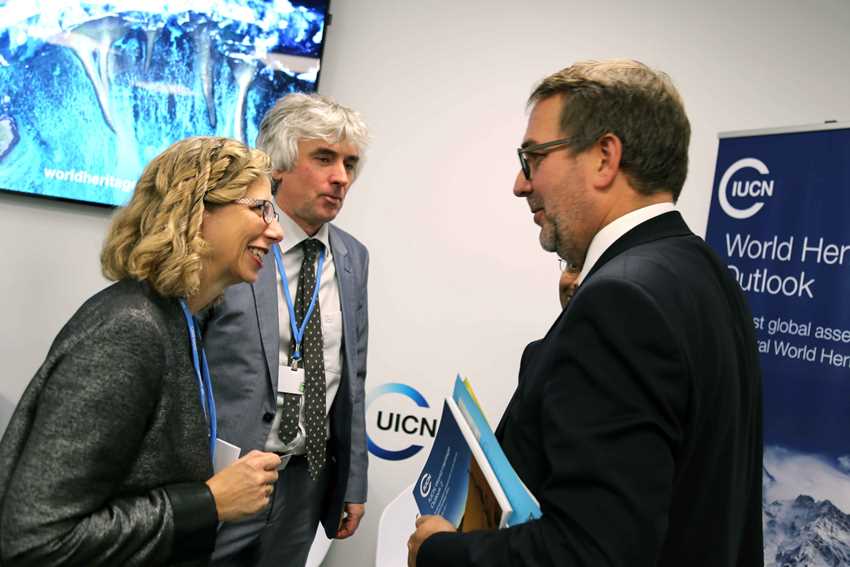IUCN and United Nations leaders join at climate change conference to discuss natural World Heritage
This week at the 2017 UN conference on climate change in Bonn (COP23), IUCN highlighted how natural World Heritage is both affected by climate change and provides solutions to its challenges. IUCN Director General Inger Andersen, UNFCCC Senior Director Martin Frick and IUCN experts gathered to launch the IUCN World Heritage Outlook 2, which reveals that the number of natural World Heritage sites threatened by climate change has nearly doubled in three years. IUCN also presented its work on the benefits of natural World Heritage and on wilderness areas, which help species survive climate change events.
Delegates gathered at the IUCN Pavilion at COP23 for the launch of the IUCN World Heritage Outlook 2, an update of the IUCN World Heritage Outlook 2014 and the first report showing whether the conservation prospects of natural World Heritage sites are improving or deteriorating over time. Inger Andersen, Director General of IUCN, presented the report’s main findings with regards to climate change. A quarter of the planet’s most outstanding places are now showing high impacts from climate change, compared to one in seven in 2014.
Martin Frick, Senior Director of the United Nations Framework Convention on Climate Change (UNFCCC), spoke on the emotional connection that people have with World Heritage sites, which form part of our collective identity, nationally and as a global community. The fact that these exceptional places are affected by climate change is a reminder of what is at stake, he said, as they define us as human beings and therefore climate change also impacts our identity.
The discussions highlighted the importance of World Heritage sites in supporting human well-being, and in particular local communities who depend on healthy ecosystems for their livelihoods. The growing impacts on World Heritage underline the need for urgent and ambitious national commitments and actions to implement the Paris Climate Agreement, as Inger Andersen reminded.
Climate change is seen among World Heritage site managers as a new kind of threat, which can hardly be addressed at the site level and whose impacts are difficult to predict. Site managers need UNFCCC to address the root causes of climate change. A key conclusion of the discussions was therefore the need to connect actions taken under the UNESCO World Heritage Convention and UNFCCC.
IUCN also presented its work, supported by the German Federal Agency for Nature Conservation (BfN), on assessing and documenting the benefits and ecosystem services provided by natural World Heritage sites. Now in its second phase, the project can support site managers and state parties in implementing the World Heritage Convention’s policy on sustainable development.
Natural World Heritage sites can provide solutions to help address climate change. They often contain very large landscapes and seascapes, which serve as refuge for species which are forced to migrate due to a changing climate. They contribute to global climate stability by storing significant amounts of carbon, which – if released to the atmosphere – would increase greenhouse gas emissions.
IUCN experts highlighted that World Heritage forests in tropical regions store 5.7 billion tons of carbon. They also presented preliminary results of a new analysis on blue carbon stocks to be released in 2018. This raised interest among delegates, who commented on the relevance of Pacific islands in the context of blue carbon. The example of East Rennell, a natural World Heritage site in the Solomon Islands, was discussed. The role of small island states is of particular significance to the Bonn conference, as Fiji is the country presiding COP23.
Find out more about IUCN's activities at the Bonn 2017 UN climate change conference on iucn.org/cop23.






